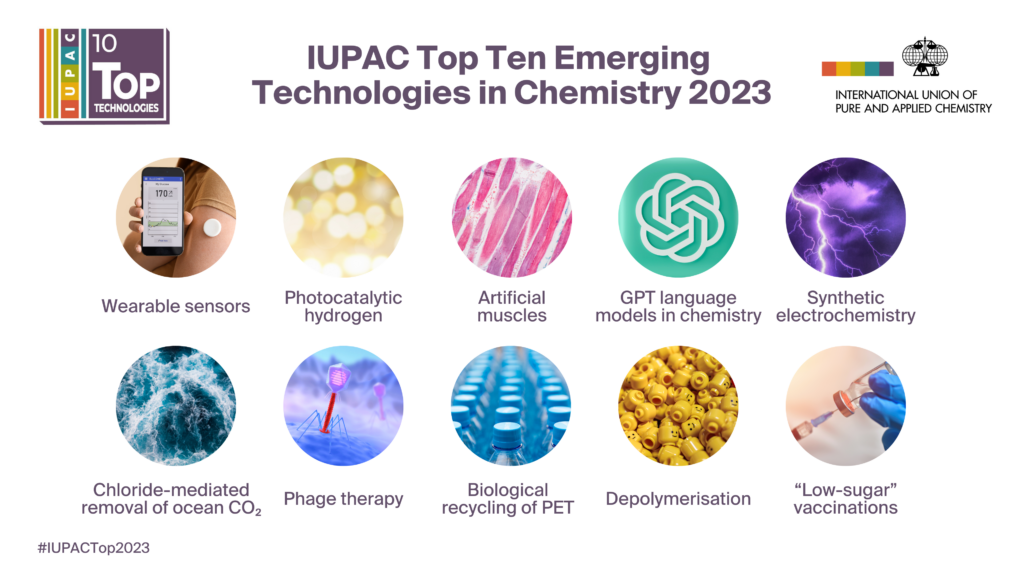The International Union of Pure and Applied Chemistry (IUPAC) has released the results of the search for the 2023 Top Ten Emerging Technologies in Chemistry. The goal of this project is to showcase the transformative value of chemistry and to inform the general public on the potential of the chemical sciences to foster the well-being of Society and the sustainability of our planet. The Jury* – an international group of objective experts with a varied and broad range of expertise – reviewed and discussed the diverse pool of nominations of emerging technologies submitted by researchers from around the globe and selected the final top ten. These technologies are defined as scientific advances in between a discovery and a fully-commercialized idea, having outstanding potential to open new opportunities in chemistry, sustainability, and beyond.
 The 2023 finalists are (in alphabetical order):
The 2023 finalists are (in alphabetical order):
- Artificial muscles
- Biological recycling of PET
- Chloride-mediated removal of ocean CO2
- Depolymerisation
- GPT language models in chemistry
- Low-sugar vaccination
- Phage therapy
- Photocatalytic hydrogen
- Synthetic electrochemistry
- Wearable sensors
IUPAC President, Professor Javier García Martínez, has said that “The challenge of providing clean energy, sufficient food, and safe drinking water for a growing world population is one of the most pressing issues of our time. To meet this challenge, we need to develop technologies that can help us achieve the Sustainable Development Goals (SDGs) by 2030. Each year, a group of international experts chosen by the International Union of Pure and Applied Chemistry (IUPAC) identifies technologies that are halfway between the laboratory and the marketplace and that have the potential to help us build a better future for all. Starting in 2019, IUPAC has offered policymakers, industry leaders, and funding agencies a roadmap designed by some of the world’s most recognized experts. This roadmap is designed to help decision-makers make informed decisions based on the best available science and technology.”
The 2023 Top Ten Emerging Technologies in Chemistry are further detailed in a feature article published in the 2023 October issue of Chemistry International (CI). Fernando Gomollón-Bel, the author of that article has said, “The 2023 Top Ten Emerging Technologies in Chemistry represent a diverse selection – from very early-stage ideas to industrialised innovations, in many different fields of chemistry, including synthesis, materials science, energy, biomedicine, and education. Perhaps instead of considering chemistry the “central science,” we should consider it the “connecting science” – one that catalyses collaboration across disciplines and encourages industrial innovation. Similarly, sustainability remains a universal subject throughout the Top Ten selections – the uttermost purpose of the initiative is still to ensure a sustainable future, advancing our society, and improving our quality of life.”
The first selection of the Top Ten Emerging Technologies in Chemistry was released in 2019 as a special activity honoring IUPAC’s 100th anniversary. The results were published in the April 2019 issue of Chemistry International, 41(2), pp. 12-17, 2019, see: https://doi.org/10.1515/ci-2019-0203). The results of subsequent initiatives and the related articles in CI can be accessed at iupac.org/what-we-do/top-ten/.
The search for the 2024 Top Ten Emerging Technologies in Chemistry has already begun and is being led again by Prof. Dr. Michael Droescher, Treasurer and General Secretary of the German Association for the Advancement of Science and Medicine. Droescher served as a judge for the initial search and has been chair of the Jury since 2020. Link here for more information on the search for the 2024 Top Ten Emerging Technologies in Chemistry.
*The following comprised the panel of judges for the 2023 Top Ten Emerging Technologies in Chemistry: Chair, Michael Droescher, (German Association for the Advancement of Science and Medicine), Jorge Alegre-Cebollada (Centro Nacional de Investigaciones Cardiovasculares, Spain), Mama el-Rhazi (Universitè Hassan de Casablanca, Morocco), Javier García Martínez (Universidad de Alicante, Spain), Ehud Keinan (Technion, Israel), Rai Kookana (CSIRO Land & Water, Australia), Juliane Sempionatto (California Institute of Technology), Mollie Shoichet (University of Toronto), Zhigang Shuai (Tsinghua University, China), Natalia P. Tarasova (D. I. Mendeleev University of Chemical Technology, Russia), and Bernard West (Life Sciences Ontario, Canada).
See also the DeGruyter Conversations, Science & Technology blog post (posted 18 Dec 2023)
About IUPAC: Founded in1919 by academic and industrial chemists as a neutral and objective scientific organization, the International Union of Pure and Applied Chemistry (IUPAC) is the world authority on chemical nomenclature and terminology, including the naming of new elements in the periodic table; on standardized methods for measurement; and on atomic weights, and many other critically-evaluated data. It was founded with the goal of uniting a fragmented, global chemistry community in order to advance the chemical sciences through collaborative efforts and the free exchange of scientific information. For more than a century IUPAC has fulfilled that goal through the creation of a common language, the standardization of processes and procedures and many diverse and global activities that ultimately impact both the chemical profession and Society as a whole. For more information on IUPAC go to: https://iupac.org/.

